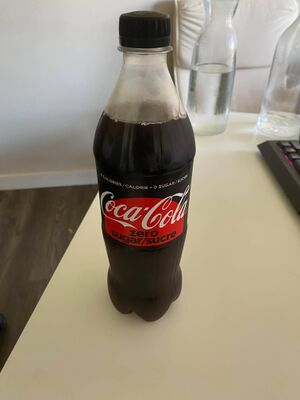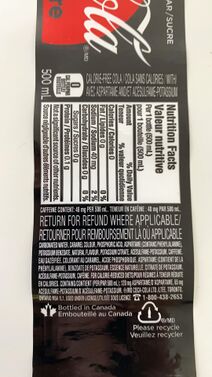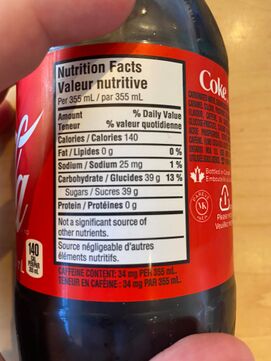Course:FNH200/Assignments/2021/Coke vs. Coke Zero
Introduction
The two products that we have chosen to compare and contrast are the regular Coke and Coke Zero. These are both popular drinks that can be bought in supermarkets, restaurants, and in convenience stores. While Coke comes in the generic red bottle, the Coke Zero comes in a black bottle to help differentiate between the two of them. Therefore, in this page, we will be identifying the difference and similarities within the ingredients and how the ingredients affect the taste of the product.
Product Photos
Within this page, we have posted images of the coke bottles as well as the labels which show the ingredients on them as well.


Ingredients List
| Ingredients | Identify fat substitutes, sugar Substitutes, additives | Explain their roles, and what they contribute to the product |
|---|---|---|
| Carbonated water | Base ingredient | Carbonated Water is the base ingredient in Coke zero. It is what makes coke zero bubbles. [1] |
| caramel colour | Additive | Gives it the brown color [2] |
| phosphoric acid | Additive | Gives it the flavor [3] |
| aspartame (contains phenylalanine) | Sugar substitute | Low calories sweetener [4] |
| potassium benzoate | Additive | preservative [4] |
| natural flavour | Additive | Gives it the flavor [3] |
| potassium citrate | Additive | pH adjusting agents, acid-reacting materials or water correcting agents [4] |
| acesulfame-potassium | Sugar substitute | Sweetener [4] |
| caffeine | Additive | Enhance the flavor of the coke [5] |
| Ingredients | Identify fat substitutes, sugar Substitutes, additives | Explain their roles, and what they contribute to the product |
|---|---|---|
| carbonated water | Base ingredient | Carbonated Water is the base ingredient in Coke zero. It is what makes coke zero bubbles. [1] |
| sugar/glucose-fructose | Additive | Acts as a sweetening agent for Coke as well as a natural preservative [6] |
| caramel flavor | Additive | Gives it the brown color [2] |
| phosphoric acid | Additive | Gives it the flavor [3] |
| natural flavour | Additive | Used for flavouring, as well as a preservative [7] |
| caffeine | Additive | Enhance the flavor of the coke [5] |
The ingredients of Coke and Coke zero are listed below. Coke and Coke Zero share four ingredients: Carbonated Water, Phosphoric acid, natural flavour, and caffeine.
Coke zero contains the ingredient caramel colour. Coke contains the ingredient caramel flavour. The caramel flavour ingredient in Coke gives Coke a caramel taste and a brown colour, where Coke Zero's caramel colour only gives a brown colour.
Coke has sugar and glucose-fructose. These two ingredients are additives that serve to sweeten the Coke. Sugar and glucose-fructose are high in calories. Coke Zero uses two low-calorie sugar substitutes, aspartame and acesulfame-potassium, to achieve a similar Coke-like taste.
In Coke, sugar is used as a preservative. In Coke zero, potassium benzoate is used to preserve Coke Zero. Potassium Benzoate is an additive.
The final ingredient in Coke zero is potassium citrate. Potassium citrate is an additive and is used to adjust the Coke Zero's PH.
Labels
- The Coke and Coke Zero bottle labels both include their list of ingredients, nutritional facts table, bilingual labelling, country of origin, quantity of the drink, as well as recycling information!
- The information on the label does comply with the regulatory requirements. The bottle has a list of ingredients, expiry date, bilingual language requirement, country of origin, etc. which is all required for compliance with labelling requirements.

Coke Zero Bottle 
Coke Zero Label 
Coke Label
References
- ↑ 1.0 1.1 "Carbonated water". Wikipedia. Retrieved July 14, 2021.
- ↑ 2.0 2.1 Vollmuth, Thomas (January 2018). "Caramel color safety - An update". Food and Chemical Toxicology. 111 – via Elsevier ScienceDirect.
- ↑ 3.0 3.1 3.2 Senese, Fred (February 23, 2018). "Why is phosphoric acid in soda pop?". General Chemistry Online. Retrieved July 14, 2021.
- ↑ 4.0 4.1 4.2 4.3 "Food Additives". Justice Law Website. July 12, 2021. Retrieved July 14, 2021.
- ↑ 5.0 5.1 "The Facts about Caffeine and Soft Drinks". Coca-Cola Australia. January 17, 2015. Retrieved July 14, 2021.
- ↑ Carbohydrates. UBC: FNH 200. pp. 2.2.1.1.
- ↑ Ivanov, Tatyana. "What Natural Flavorings are in Coca-Cola?". Leaf. Retrieved July 14, 2021.


